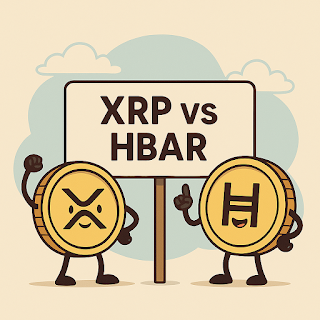XRP vs HBAR: The Battle for Blockchain Dominance in Enterprise Payments (2025 Edition)
As we move deeper into 2025, two tokens are defining the next phase of blockchain adoption: XRP and HBAR. Each is engineered for performance, trusted by institutions, and built with a long-term vision. But their strengths and strategies differ, and that makes the choice between them more relevant than ever.
Why XRP and HBAR Are Leading the Conversation This Year
Ripple's XRP has seen a resurgence after regulatory clarity in the U.S., unlocking partnerships with global banks and payment providers. On the flip side, Hedera’s HBAR is rapidly expanding through public-private collaborations, with a focus on sustainability and enterprise-grade applications. From decentralized identity to ESG reporting, HBAR is pushing boundaries that go beyond payments.
Speed, Cost & Performance
Speed matters when transactions scale. XRP settles transactions within 3–5 seconds, which is fast but HBAR clocks in with over 10,000 transactions per second and near-instant finality. It’s also cheaper. While both tokens boast low fees, HBAR’s micro-fee model is more predictable, especially for high-volume enterprise apps.
Technologically, XRP operates on the Ripple Protocol Consensus Algorithm, using a trusted validator list. HBAR, however, is built on the Hashgraph consensus model an alternative to blockchain that offers fairness, security, and exceptional throughput.
Finance vs Tech Infrastructure
XRP’s strength lies in international finance. Banks, payment rails, and remittance services rely on it to simplify cross-border settlements. HBAR, by contrast, is shaping the future of Web3 utility. It’s being adopted in climate data systems, tokenized assets, and logistics networks. Google, IBM, and Boeing sit on its governing council not just as investors but as users.
This divergence shows in how projects are built. XRP powers the financial pipes. HBAR powers platforms, APIs, and apps.
Real-World Use in 2025
In today’s market, functionality beats speculation. HBAR is being used in new-generation crypto wallets, including hybrid platforms like Ment Tech’s wallet with in-app shopping, which combines smart contract payments, loyalty tokens, and Web3 shopping all on-chain. This is where HBAR’s speed and predictability shine.
Meanwhile, XRP is being integrated into traditional systems, offering institutional clients a stable, liquid bridge between currencies.
The Decentralization Debate
Neither XRP nor HBAR is fully decentralized, but both are evolving. Ripple still governs much of the XRP validator infrastructure, which has sparked debates. Hedera started with corporate governance too, but its 39-member council model is gradually opening to community participation. In the decentralization race, HBAR shows more structural momentum.
Final Thoughts:
If you’re looking for legacy integration, XRP fits. It has proven reliability in financial services and increasing regulatory support. But if you want a token built for scale, sustainability, and the composable future of blockchain apps, HBAR has the edge.
From crypto wallets to enterprise APIs, HBAR is becoming a tool for builders. Ment Tech and others are already showing how it can power real products. The future of digital payments won’t be shaped by speculation, it’ll be shaped by systems that work. And in 2025, both XRP and HBAR are putting in the work, just in very different ways.


Comments
Post a Comment